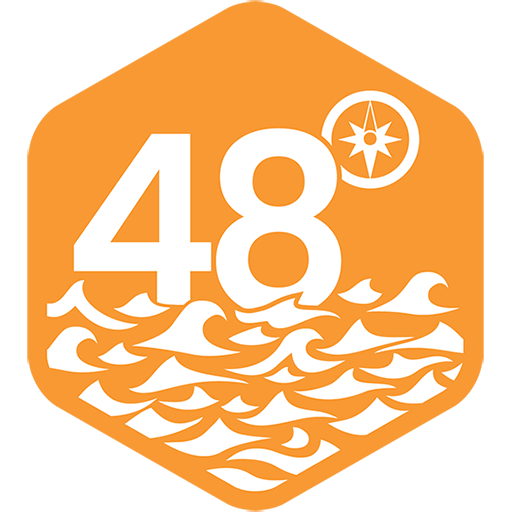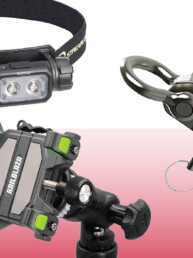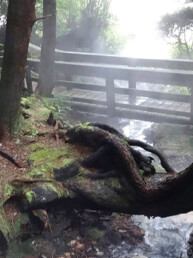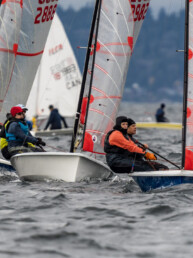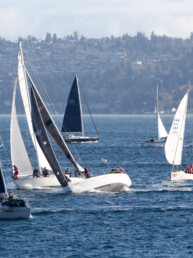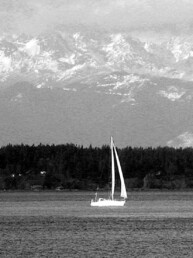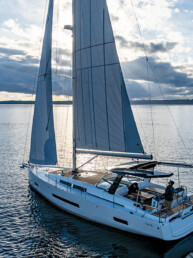Whether it’s potential new owners, hardcore boat geeks, or casual passersby, unique boats tend to have a way of drawing people to them. To this end, Argonaut II is a classic example.
A lifelong sailor and transplant from the east coast to Seattle, Nicholas Verrochi was captivated by the 73-foot wooden vessel that sat at the end of the dock at Stimson Marina in Salmon Bay.
“I am always looking at used boats on Craigslist, and regularly find undervalued boats that I fix up, play around with, and sell to fund the next one,” he said. “For six months, I saw Argonaut II for sale and loved clicking through the photos, but never put any mind to purchasing an old boat of that size… or a motorboat. After learning more about the strong liveaboard community in Seattle, the idea popped into my head to take on a project like Argonaut II, turn it into a small charter business, and use the income to fund a restoration. Meanwhile, I could work remotely from places like the San Juan Islands and do weekend trips up and down Puget Sound.”
He took the plunge and purchased Argonaut II in 2021, and has since cruised thousands of miles up and down the Inside Passage. Thus, the tale of distinctive boats captivating people continues, as does the unique and storied history of Argonaut II.
What is your background in boating?
I have always been a sailor, and grew up in community sailing programs outside of Boston, Massachusetts. In college, I raced for the University of Delaware and afterwards co-owned and operated a summer boating camp, as well as a sailboat and kayak rental business with 10 locations across New England and Washington, DC. I learned to love wooden boats through sailing in Maine, and acquired my first wooden boat, a 14-foot Whitehall rowboat, in 2012.
When I moved to Seattle in March 2020, I purchased a 1948 Kettenberg PC 32 sailboat, Orion, and sailed Puget Sound and the San Juan Islands. Of course, I fell in love with cruising in the Pacific Northwest. This led me to search for a place to live by the water in Seattle, which is where I found Argonaut II and fell in love with her rich history.
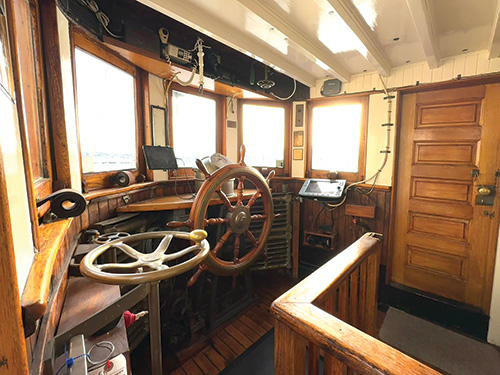
Tell us more about Argonaut II and its past lives.
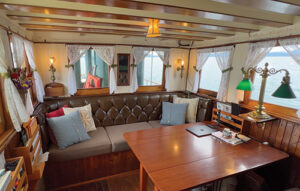
This boat is one of the most historic vessels in the Pacific Northwest. For 103 years, it has lived many lives as a corporate yacht, commercial tugboat, and private liveaboard; but most famously, it was a mission boat that intimately touched the lives of thousands of people each year.
Argonaut II was designed by Edson B. Schock and built by W.R. Menchions Shipyard in Coal Harbour, Vancouver, British Columbia in 1922. She is 73 feet in length overall (61 feet at the waterline) and weighs 54 tons. Originally, she was commissioned as a private yacht for Sheldon Brooks (1878 – 1946) who christened the boat Greta M after his wife, Greta Hutchinson MacDonald. The boat then served as a corporate yacht for the Powell River Company, taking executives to and from the remote logging operations up the coastline of British Columbia, or entertaining corporate guests, family, and friends for pleasure cruises.
Greta M was powered by a large three-cylinder Fairbanks Morse marine diesel engine and operated by a crew of three, who stayed forward of the engine room in crew quarters below the pilot house.
The space aft of the engine room includes the galley, originally heated with a diesel stove, a luxurious aft salon with a wood-fired stove, and an aft state room with a separate head and bunks for two guests. Including fold-up bunks in the salon, there are nine beds that accommodate 12 people on board.
In 1937, the United Church of Canada purchased the boat and renamed her Thomas Crosby IV after a famous missionary from the 19th century—the boat became the fourth in a series of five boats that served the United Church up and down the remote coastline of British Columbia. The church performed some major upgrades to the boat, including the installation of a large hydraulic windlass on the bow, and updated the aft salon and state room with beautiful stained glass windows, refrigeration, and benches that chained to the ceilings to create additional bunks.
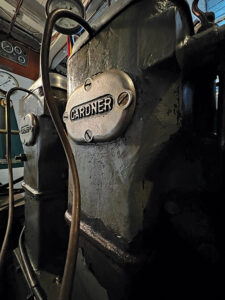
The boat was repowered in 1940 with an air-start Gardner 6L3 marine diesel engine complete with a Gardner reduction gear. The engine now has somewhere between 120,000 and 150,000 hours on it, and still runs quite efficiently burning only 2.2 gallons per hour with a cruising speed of 8.2 knots. I recently learned that the boat was historically run at 9 knots, and am currently working on finding ways to gain back that efficiency by rebuilding the fuel injectors or adjusting the timing of the cylinders.
As a mission boat, the Thomas Crosby IV was based out of Ocean Falls and served more than 50 ports of call, covering the northern half of the British Columbia coast. These included 18 lighthouses, remote settlements, canneries, logging operations, and First Nations communities as far as Smith Inlet to the south and Lowe Inlet to the north. Every six weeks, the boat would perform two trips—one to the north, the other to the south, stopping in Ocean Falls to resupply. Run by an engineer, a deckhand, and a minister and his wife, the United Church operated the boat for 50 weeks per year, averaging 1,200 miles each month.
Thomas Crosby IV was operated by several significant historical figures, including the Reverend Peter Reginald Kelly (1885-1966) who was a prominent member of the Haida First Nation and an Indigenous rights activist. Kelly served as part of the Native Brotherhood in the 1930s and was a key figure in the consultations in the 1940s that led to revisions of the Indian Act. He was the first college-educated Haida Chief who was ordained into the United Church and served as a minister aboard the Thomas Crosby III and Thomas Crosby IV.
Another prominent and controversial figure who occasionally operated the boat was Dr. George Darby of the R.W. Large Memorial Hospital in the Heiltsuk First Nation community of Bella Bella, the longest-standing leader of the hospital of 45 years. The hospital was established to serve primarily the Heiltsuk Nation, and Dr. Darby is known for the treatment of tuberculosis amongst First Nations and other coastal communities. Darby also played a significant role in the mission of the United Church, and there are two sides to this story with some darker histories of treatment of the very people he was there to serve.
What has been interesting to learn in my own journeys retracing the history of this boat—as a non-Canadian outsider who is new to the history and culture of the Pacific Northwest—is that the two sides of the stories were split across different demographics than I imagined. Stories from both First Nations elders and former Canadian loggers, fishermen, or coastal community members reflected fondly over this time, citing the community and services the boat would render to remote villages who seldom received visits from anybody else. When engaging with the younger generations, I’ve been met with hesitancy and a more regretful conversation around the history of the United Church which, in conjunction with the Canadian government, actively suppressed the rich culture of First Nations communities. As it stands now, Dr. Darby’s name and the church mission are being removed from names of public buildings and historical sites.
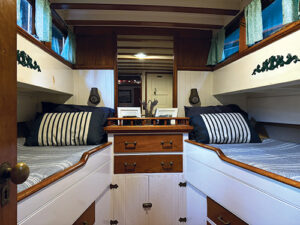
In 1966, the United Church sold Thomas Crosby IV to Blackmore Marine Services Ltd. out of Vancouver, British Columbia, where she was renamed Argonaut II and saw quite a rapid decline while being operated commercially as a tugboat.
In 1971, a man named Julian Matson purchased the boat and performed a great deal of restoration work and maintenance out of Boat Harbour on Vancouver Island, thus setting Argonaut II up to be able to reach her 100th birthday. Julian was the caretaker of the vessel for more than 30 years, and shared Argonaut II with many people across the Canadian boating community.
Over my time with the boat, I have met dozens of people who both lived and worked on it, and were even married on it. I have heard rumors of Julian’s friendship with the American movie actor, John Wayne, who enjoyed cruising the southern Canadian waters on his yachts Wild Goose and Norwester. This may or may not be true, but I have been told that Argonaut II’s tender, Lil’ Argo, was formerly a dinghy owned by John Wayne, who traded it to Julian for a brass cannon. We now give the dinghy the nickname, “JWD,” or the “John Wayne Dinghy.”
Since 2002, Argonaut II has passed through several owners, and the boat moved to Stimson Marina in Seattle. She has stayed in the same end-slip as a flagship boat of the marina and a recognized landmark in Salmon Bay. More recently, the boat has primarily been used as a live aboard, but I am on a mission to return Argonaut II to its full capabilities of cruising the remote coastlines of the Pacific Northwest and sharing it with as many people as I can.
Since purchasing Argonaut II in 2021, I have put nearly 400 days underway covering more than 6,000 miles up and down Puget Sound and the Inside Passage.
What do you like best about your boat?
I love how much Argonaut II has touched the lives of so many people. Unlike private yachts or commercial ships, she’s made an impression on thousands of people in an extraordinary way throughout her history, creating intimate connections throughout remote areas alive with people who depended on Argonaut II for supplies, transportation, community, and even medical needs. With each stop I make along the coastline, people come up to the boat eager to share stories of their childhood memories aboard her—how their parents were married or christened on the boat, how they had their tonsils removed aboard, or worked as a deckhand, minister, or engineer. Often, it feels as though the entire village community wants to come down to the dock and connect with me and see the boat again.
I also appreciate Argonaut II’s unique, regal look of classic beauty, and the way she draws even those who are unfamiliar with classic yachts to take a look and ask a question. I love when people come to tell me a story of an old wooden boat they enjoyed and labored over with their family, or simply ask about Argonaut’s history not knowing much about boats but sensing there’s something there to ask about. I enjoy inviting the curious aboard to have a tour or a drink, and the boat has served as an incredible way for me to build my own community. I owe it to the boat’s history to continue sharing it with as many people as I can.
What do you know now about your boat that you wish you’d known when you bought it? Would that have changed your mind?
I knew a fair amount of the boat’s history when I purchased it, and loved how classy the boat felt on the inside—stepping through the pilot house or the salon is like a step back in time. I knew I was taking on a big project, likely something larger than I could handle, but was interested in the challenge of something new and the opportunity to create my own contribution to the boat’s legacy.
When I first encountered Argonaut II, I knew that the boat was behind in its maintenance schedule as a wooden boat, and knowingly purchased it with the intention of rebuilding the starboard side. In 2023, I hauled the boat out in Port Townsend, and with the leadership of the shipwrights Pete Stein, Quillan Hunt, and Rowan Schatz, replaced 37 planks and 22 frames on the starboard side, along with the inner and outer sponson, guard, and miscellaneous projects over the course of a 10-week, very intensive haulout resulting in 2000+ hours of work. I committed a certain amount of initial investment into the boat, but this was all that I could afford. I am currently working to fundraise to perform a similar, and much larger, repair on the port side (mainly via YouTube and Patreon under the name “Argonaut II”, and direct donations on my website,
www.argonaut1922.com). I plan to document these repairs on YouTube to continue sharing this boat’s ongoing story with the rest of the world.
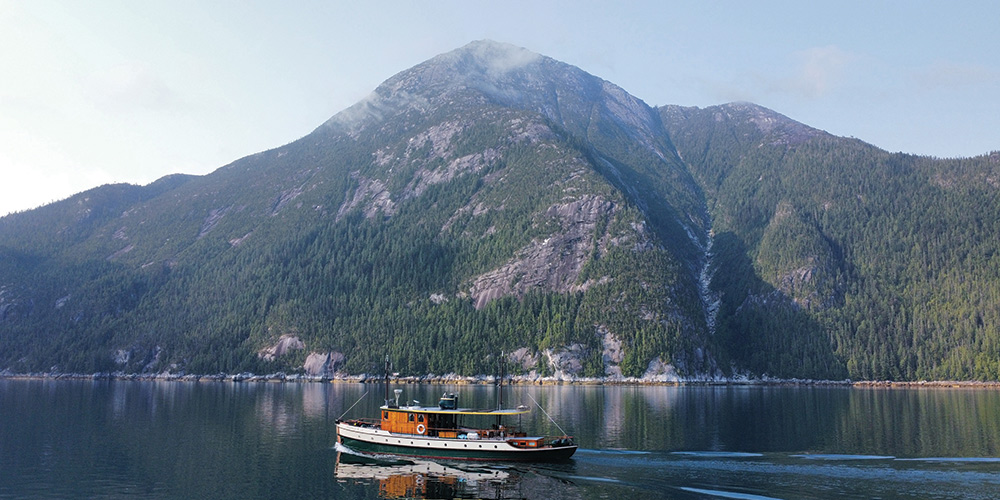
What’s your favorite story involving your boat?
This past summer, I took time off of work to embark on a personal endeavor to retrace the history of Argonaut II up the remote coastline of Northern British Columbia, and document the journey on YouTube. Now back from my four-month, 2,100-mile journey, I am proud to have visited many of her old ports of call when she was a mission boat and met hundreds of people with stories of personal connection to the boat. I also shared this journey with some great friends, and can narrow my favorite stories down to two.
First, after supporting the Race to Alaska, I began my journey north alongside another “really old and quite famous boat,” Tally Ho!, crewed by a team of young people involved in the restoration of wooden boats and keeping the tradition of wooden boat building and stewardship alive among younger generations. Part of my passion for wooden boats is to inspire young people to keep caring for these wonderful pieces of history and examples of traditional craftsmanship. 48° North readers will likely be familiar, but if you don’t know the story, Tally Ho! represents this well as an incredible seven-year endeavor of a seemingly impossible restoration project of a 1910 gaff-rigged cutter led by Leo Goolden. This summer, he and his crew embarked on a shakedown cruise and we decided to share the northbound segment of our journeys, because the only thing better than boating is boating with friends who share your same passion.
What was rewarding about this experience is that each night, we dropped the hook in a different beautiful anchorage and rafted alongside each other—about a dozen of us—to truly enjoy everything that cruising has to offer. The cast of crew were a mix of my friends from Seattle, shipwrights, riggers, and tradespeople who supported the project, and friends whose backgrounds include working as captains, engineers, and deckhands on yachts around the world. At every stop, the activity was instantaneous, jumping into the water, throwing dinghies, paddleboards, and floats over the side, freediving, crabbing, and fishing, as well as exploring ashore. This came at a time of my life where I was having a lot of difficulty personally, and sharing everyone’s cruising happiness lifted my spirits. It’s one of the best memories I will ever have.
I also had a special moment towards the tail end of my journey. While I was heading north through Dent Rapids, I passed a sailboat captained by Phil Little who hailed me on the radio exclaiming that he was the engineer aboard Argonaut II back in 1959 when she was the Thomas Crosby IV. We exchanged contact information and I reached out three months later as I headed south to Vancouver and overnighted at Heritage Harbour at the Vancouver Maritime Museum.
Not only was I able to host Phil aboard, but he also joined me several days later on a crossing of the Strait of Georgia to Sidney on Vancouver Island. I learned about his time aboard Thomas Crosby IV, the people he encountered along the coastal communities in the 1950s and 1960s, and a thing or two about the boat. Phil connected me with longtime friends of his, Bob and Joan Burrows, who served with him aboard Argonaut II. Bob was a United Church minister, and he and Joan served on Thomas Crosby IV from 1960-1962 alongside Phil. Inviting them aboard and re-living their experiences and observing their reactions to the boat was a very special experience.
What didn’t we ask you about your boat that you wish we had?
I would like to share just how unique and wonderful it is to have encountered such a strong liveaboard community in Seattle, and all the interesting characters and personalities who share a passion for the water and have discovered a secret to living in small slices of waterfronts around Puget Sound. In a similar regard, the shipyard in Port Townsend is bustling with tradespeople who are passionate about what they do, showcase craftsmanship and traditional woodworking at the highest level, and share in a community serving as a foundation that’s keeping these old wooden vessels alive.
Wooden boat stewardship is a costly, time-consuming, and dying art form, and each year you see more and more boats head to the crusher. I do note a growing interest among young people who see the romance in the history and maritime tradition that these boats have to offer. I am passionate about sharing this worthy endeavor and spirit of restoration and preservation with as many people as I can. I’m a firm believer in supporting the trades, supporting the history, and learning about just how much the maritime community touches the lives of people up and down the coast.
Editor
48° North Editors are committed to telling the best stories from the world of Pacific Northwest boating. We live and breathe this stuff, and share your passion for the boat life. Feel free to keep in touch with tips, stories, photos, and feedback at news@48north.com.
